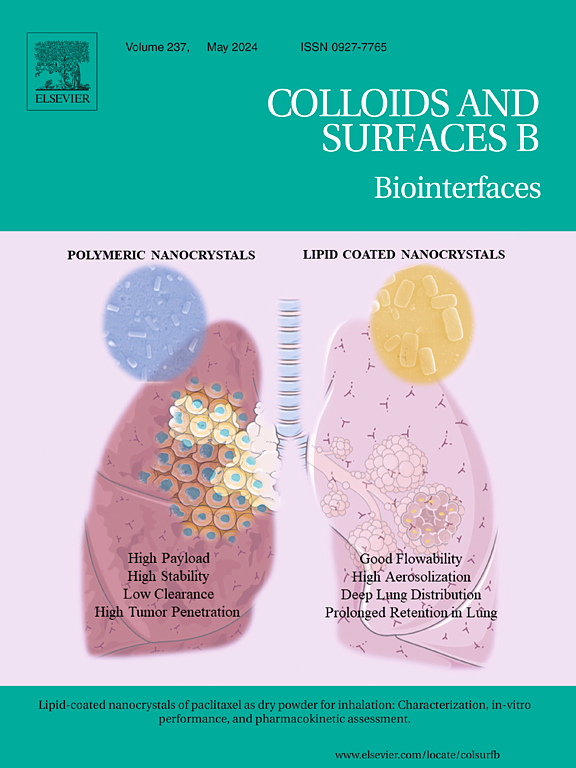Preparation and characterization of crosslinked kudzu porous starch hemostatic
IF 5.4
2区 医学
Q1 BIOPHYSICS
引用次数: 0
Abstract
Rapid and effective hemostasis is essential for the management of battlefield injuries and traumatic hemorrhages. Among various hemostatic agents, starch-based materials have attracted considerable attention due to their favorable biocompatibility, low immunogenicity, and cost-effectiveness. However, the potential of kudzu starch (KS) as a raw material for hemostatic applications remains underexplored. In this study, porous kudzu starch (PS) was crosslinked with sodium trimetaphosphate (STMP) to synthesize a novel hemostatic agent, STMP/PS (SPS), with enhanced functional performance. The structural and physicochemical properties of SPS were systematically characterized using Fourier-transform infrared (FT-IR) spectroscopy, Brunauer–Emmett–Teller (BET) surface area analysis, and other analytical techniques, confirming successful chemical modification and the formation of a highly porous architecture. SPS exhibited excellent water absorption and dye adsorption capacities. Hemostatic efficacy was evaluated through a series of in vitro and in vivo models, where SPS demonstrated significantly improved performance compared to a commercially available hemostatic product. Mechanistic investigations revealed that SPS facilitates red blood cell aggregation and platelet adhesion, thereby accelerating the coagulation cascade. In addition, biosafety assessments, including cytotoxicity, acute toxicity, and hemolysis assays, confirmed its excellent biocompatibility and low toxicity. These findings underscore the clinical potential of SPS as a rapid, effective, and safe starch-based hemostatic material.
交联葛根多孔淀粉止血剂的制备与表征
快速有效的止血对于处理战场创伤和创伤性出血至关重要。在各种止血剂中,淀粉基材料因其良好的生物相容性、低免疫原性和成本效益而备受关注。然而,葛淀粉(KS)作为止血原料的潜力仍未得到充分开发。本研究将多孔葛淀粉(PS)与三甲基磷酸钠(STMP)交联,合成了一种功能性能增强的新型止血剂STMP/PS (SPS)。利用傅里叶变换红外光谱(FT-IR)、布鲁诺尔-埃米特-泰勒(BET)表面积分析等分析技术对SPS的结构和物理化学性质进行了系统表征,证实了SPS成功的化学改性和高多孔结构的形成。SPS具有优异的吸水和染料吸附能力。通过一系列体外和体内模型评估止血效果,与市售止血产品相比,SPS表现出显着改善的性能。机制研究表明,SPS促进红细胞聚集和血小板粘附,从而加速凝血级联。此外,生物安全性评估,包括细胞毒性、急性毒性和溶血试验,证实了其良好的生物相容性和低毒性。这些发现强调了SPS作为一种快速、有效和安全的淀粉基止血材料的临床潜力。
本文章由计算机程序翻译,如有差异,请以英文原文为准。
求助全文
约1分钟内获得全文
求助全文
来源期刊

Colloids and Surfaces B: Biointerfaces
生物-材料科学:生物材料
CiteScore
11.10
自引率
3.40%
发文量
730
审稿时长
42 days
期刊介绍:
Colloids and Surfaces B: Biointerfaces is an international journal devoted to fundamental and applied research on colloid and interfacial phenomena in relation to systems of biological origin, having particular relevance to the medical, pharmaceutical, biotechnological, food and cosmetic fields.
Submissions that: (1) deal solely with biological phenomena and do not describe the physico-chemical or colloid-chemical background and/or mechanism of the phenomena, and (2) deal solely with colloid/interfacial phenomena and do not have appropriate biological content or relevance, are outside the scope of the journal and will not be considered for publication.
The journal publishes regular research papers, reviews, short communications and invited perspective articles, called BioInterface Perspectives. The BioInterface Perspective provide researchers the opportunity to review their own work, as well as provide insight into the work of others that inspired and influenced the author. Regular articles should have a maximum total length of 6,000 words. In addition, a (combined) maximum of 8 normal-sized figures and/or tables is allowed (so for instance 3 tables and 5 figures). For multiple-panel figures each set of two panels equates to one figure. Short communications should not exceed half of the above. It is required to give on the article cover page a short statistical summary of the article listing the total number of words and tables/figures.
 求助内容:
求助内容: 应助结果提醒方式:
应助结果提醒方式:


